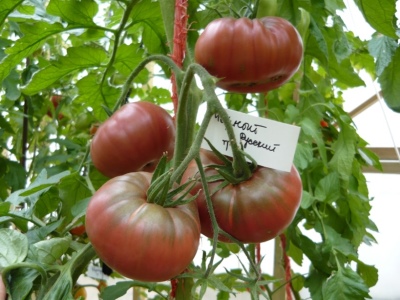
- Category: grade
- Growth type: indeterminate
- Appointment: fresh consumption
- Ripening period: mid-season
- Ripening time, days: 110-115
- Growing conditions: for open ground, for film greenhouses
- Bush size: tall
- Bush height, cm: 170-200
- Ripe fruit color: black-crimson top, crimson bottom
- Fruit shape: flat-round, ribbed
Tomatoes with an unusual color are gaining popularity among Russian vegetable growers. The Black Russian variety will delight summer residents with a beautiful, tasty and healthy harvest. The harvested crop can be stored for a long time and you can enjoy fresh vegetables for a long time after the end of fruiting.
Description of the variety
Tall bushes reach a height of 1.7-2 meters. Due to their high taste, the fruits are most often eaten fresh. Growth is indeterminate. The variety is suitable for closed (glass, film and unheated greenhouses) or open ground. The second option is more preferable for southern regions with a warm and favorable climate. Up to 5 fruits are formed in each brush. Leaves are small, dark green in color. The plant mass is dense.
During fruiting, the bushes are covered with a large number of bright fruits, which increase the decorative effect of the plant.
The main qualities of the fruit
Ripe tomatoes Black Russian have a non-standard color. The lower part of the fruit is crimson, the upper is black and crimson. Initially, the color of tomatoes is light green. The sizes are marked as large. In weight, they gain from 170 to 250 grams. The tomatoes are covered with ribs, the shape is flat-round. Some specimens grow slightly depressed. When cut, a large number of seed nests can be found.
The color saturation depends on the intensity of the sun color. Under the influence of bright sunlight, the skin becomes darker.
Taste characteristics
The flavoring qualities of the variety are at their best. The taste is balanced and sweet. There is no sour taste. The fruits contain a large amount of vitamin B. It also contains choline and provitamin A.
Ripening and fruiting
Black Russian belongs to mid-season varieties. Bushes need 110 to 115 days to form juicy vegetables. Harvested between July and September. Plants bear fruit for a long period.
Yield
A high-yielding fruit crop produces from 8 to 11 kilograms of vegetables per square meter of the plantation. The return from one bush is about five kilograms. Observing all the conditions of agricultural technology, you can increase the yield by 20%.
The timing of planting seedlings and planting in the ground
Seeds are sown in early March (March 1-15). Before use, the grains are treated with compounds that stimulate growth. Seedling soil can be purchased or prepared from a mixture of humus and garden soil. In the process of growing, the grains are deepened a little, and the planting is sprayed with warm water. Containers with seeds are covered with a thick film or glass.
If at the first stages the tomatoes do not need lighting, then with the emergence of seedlings they are transferred to the sun. In cloudy weather, the lack of natural lighting is compensated for with special lamps. Water heated to 20-22 degrees is used for irrigation.
The pick is carried out after the formation of several leaves. After planting, the seedlings are fertilized with complex compounds. Plants are transferred to the ground in mid-May to June 5th. The earth is pre-fed with humus, and a tablespoon of wood ash is sent to each planting hole.
The tomato prefers moderate watering using only settled and warm water. Black Russian fertilizer sensitive. Nitrogen-containing formulations are used before flowering. They switch to magnesium sulfate after the formation of ovaries. And you can also treat the bushes with a superphosphate solution.

Growing tomato seedlings is an extremely important process, because it largely depends on whether the gardener can harvest at all. All aspects must be taken into account, from seedbed preparation to planting in the ground.
Landing scheme
Up to three bushes are planted on one square meter of the site. And the following landing pattern is also widespread - 60 x 50 centimeters.

Growing and care
To improve the quality of the harvest, the plants are formed in 1-2 stems, sometimes the option of 2-3 stems is used. Unnecessary stepchildren who grow above the third fruit cluster are pruned. For better ovary formation, remove excess buds and lower leaves. When growing a variety, you will need strong supports. Shoots are tied to trellises or stakes.
The soil on the site must be periodically loosened. The work is performed in between waterings. To keep the soil loose and moist longer, the beds are covered with mulch. It is also an effective prevention of root rot. Peat or humus is used as mulch. Some gardeners opt for dry grass.
Industrial insecticides will help protect tomatoes from harmful insects. These are effective remedies, but they must be applied carefully so as not to harm the plants. Among folk remedies, infusions based on onion peels, celandine, laundry soap or ammonia are used.
Other components of agricultural technology:
fertilization during transplantation (2 tablespoons of double superphosphate are consumed per plant);
water consumption during irrigation - 5 liters per one bush;
cleaning the territory from weeds;
preventive treatment of plants;
compulsory formation;
a month before the fruits ripen, feeding is stopped.




A plant needs different micronutrients at each stage of growth. All fertilizers can be divided into two groups: mineral and organic. Folk remedies are often used: iodine, yeast, bird droppings, eggshells.
It is important to observe the rate and period of feeding. This also applies to folk remedies and organic fertilizers.



























































































